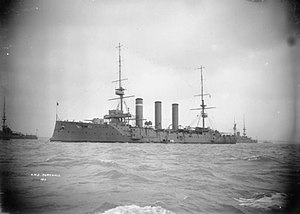HMS Cornwall (1902)
 Cornwall at anchor
| |
| History | |
|---|---|
| Name | Cornwall |
| Namesake | Cornwall |
| Builder | HM Dockyard, Pembroke |
| Laid down | 11 March 1901 |
| Launched | 29 October 1902 |
| Christened | by Emily Harriet, Countess of St Germans |
| Completed | 1 December 1904 |
| Fate | Sold for scrap, 7 July 1920 |
| General characteristics | |
| Class and type | armoured cruiser |
| Displacement | 9,800 long tons (10,000 t) (normal) |
| Length | 463 ft 6 in (141.3 m) (o/a) |
| Beam | 66 ft (20.1 m) |
| Draught | 25 ft (7.6 m) |
| Installed power |
|
| Propulsion | 2 × shafts; 2 × triple-expansion steam engines |
| Speed | 23 knots (43 km/h; 26 mph) |
| Complement | 678 |
| Armament |
|
| Armour |
|
HMS Cornwall was one of 10
In 1909 she toured the Mediterranean and the Baltic, where she entertained the Kaiser who visited on his yacht the Hohenzollern at Kiel on 24 June.[1]
Cornwall ran aground in 1911 while trying to free another cruiser, but was successfully refloated and repaired.
She captured a German merchant ship days after the beginning of
Design and description

The Monmouths were intended to protect British merchant shipping from fast
The Monmouth-class ships' main armament consisted of fourteen
Beginning in 1915, the main deck six-inch guns of the Monmouth-class ships were moved to the upper deck and given
The ship's
Construction and service
Cornwall, named to commemorate the
In December 1913, the ship was refitting in
After the German raider Cap Trafalgar was sunk, RMS Carmania was badly damaged, having lost nine men, but was able to rendezvous with Cornwall. Carmania was barely afloat when it made contact with Cornwall on 15 October. Carmania was escorted to Permambuco in Brazil where the ship was repaired before being sent to Gibraltar for further repair.
The ship was later assigned to a new squadron intended to patrol the River Plate area and did not join Craddock's ships as they searched for the German East Asia Squadron off the Chilean coast.[15] After Craddock's squadron was destroyed in the Battle of Coronel on 1 November, Cornwall then proceeded to the Falkland Islands with the squadron commanded by Vice-Admiral Doveton Sturdee.[16]
Battle of the Falklands

Upon arrival at
In accordance with Sturdee's plans, Cornwall, her
Subsequent service

She arrived at Devonport on 11 February 1915 and spent the next month and a half refitting there and in
A few days after arriving in
Notes
- ^ "Cwt" is the abbreviation for hundredweight, 12 cwt referring to the weight of the gun.
Footnotes
- ^ Purser (1909). "Purser's diary, Royal Navy Armoured Cruiser HMS Cornwall, under Captain (later Admiral Sir) William Reginald Blinker Hall (1870-1943), future Director of Naval Intelligence". Retrieved 26 April 2019.
Manuscript diary of the purser of the Royal Navy Armoured Cruiser HMS Cornwall, describing Mediterranean and Baltic tours of duty (while Captain W. R. Hall was spying for Britain)
{{cite journal}}: Cite journal requires|journal=(help) - ^ a b c Roberts, p. 70
- ^ a b Friedman 2012, p. 336
- ^ Friedman 2011, p. 81
- ^ Friedman 2012, pp. 251–252, 260–261
- ^ Friedman 2012, pp. 280, 286
- ^ McBride, p. 21
- ^ Silverstone, p. 224
- ^ "Naval & Military Intelligence". The Times. No. 36403. London. 15 March 1901. p. 4.
- ^ "Naval & Military intelligence". The Times. No. 36912. London. 30 October 1902. p. 10.
- ^ a b Preston, p. 12
- ^ a b c d e f g h i Transcript
- His Majesty's Stationery Office. 18 December 1913. Retrieved 1 April 2016.
- ^ Corbett, I, pp. 41–43
- ^ Corbett, I, pp. 263, 314, 318
- ^ Massie, pp. 244, 249
- ^ Massie, pp. 258–265
- ^ Massie, pp. 267, 275–277
- ^ Corbett, II, p. 405; III, pp. 8, 64
- ^ "Supplement to the Monthly Navy List Showing the Organisation of the Fleet, Flag Officer's Commands, &c". National Library of Scotland. Admiralty. January 1916. p. 21. Retrieved 1 April 2016.
- ^ Newbolt, IV, p. 210
- ^ Newbolt, V, p. 135
Bibliography
- ISBN 0-89839-256-X.
- Corbett, Julian (1997) [1929 second]. Naval Operations. History of the Great War: Based on Official Documents. Vol. II. London and Nashville, Tennessee: Imperial War Museum in association with the Battery Press. ISBN 1-870423-74-7.
- Corbett, Julian (1997) [1940]. Naval Operations. History of the Great War: Based on Official Documents. Vol. III (Second ed.). London and Nashville, Tennessee: Imperial War Museum in association with the Battery Press. ISBN 1-870423-50-X.
- ISBN 978-1-59114-068-9.
- Friedman, Norman (2011). Naval Weapons of World War One: Guns, Torpedoes, Mines and ASW Weapons of All Nations; An Illustrated Directory. Barnsley, UK: Seaforth Publishing. ISBN 978-1-84832-100-7.
- ISBN 0-679-45671-6.
- McBride, Keith (1988). "The First County Class Cruisers of the Royal Navy, Part I: The Monmouths". Warship. 46 (April). London: Conway Maritime Press: 19–26. ISSN 0142-6222.
- ISBN 0-89839-253-5.
- Newbolt, Henry (1996) [1931]. Naval Operations. History of the Great War Based on Official Documents. Vol. V. Nashville, Tennessee: Battery Press. ISBN 0-89839-255-1.
- ISBN 0-85177-245-5.
- Roberts, John (1979). "Great Britain and Empire Forces". In Chesneau, Roger & Kolesnik, Eugene M. (eds.). Conway's All the World's Fighting Ships 1860-1905. Greenwich, UK: Conway Maritime Press. pp. 1–113. ISBN 0-8317-0302-4.
- Silverstone, Paul H. (1984). Directory of the World's Capital Ships. New York: Hippocrene Books. ISBN 0-88254-979-0.
- "Transcript: HMS Cornwall – December 1913 to August 1919, Central Atlantic, Mediterranean, South Atlantic, Battle of the Falklands, East Indies Station, China Station, North Atlantic Convoys, North America & West Indies Station". Royal Navy Log Books of the World War 1 Era. Naval-History.net. Retrieved 1 April 2016.
